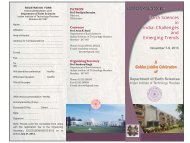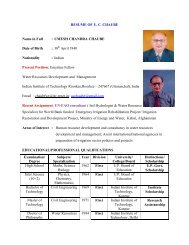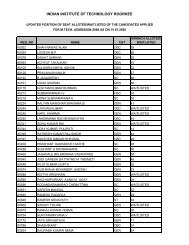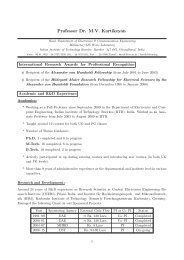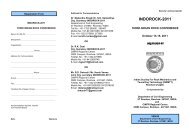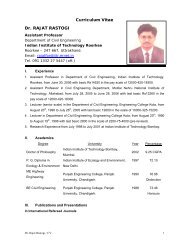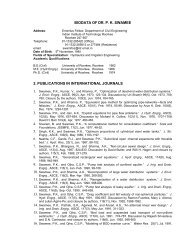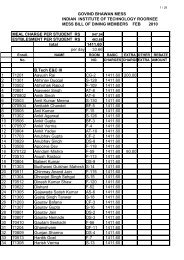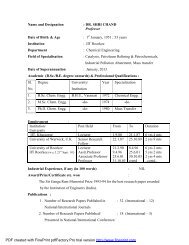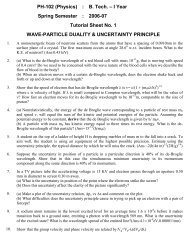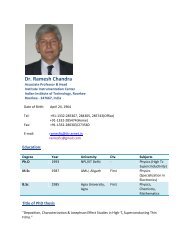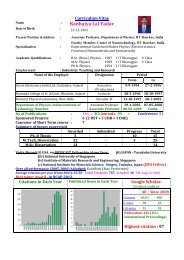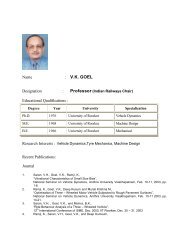Rohit Bansal - IIT Roorkee
Rohit Bansal - IIT Roorkee
Rohit Bansal - IIT Roorkee
- No tags were found...
Create successful ePaper yourself
Turn your PDF publications into a flip-book with our unique Google optimized e-Paper software.
UDAAN… a Scholar’s QuarterlyJanuary-March 2011finance
ForewordJanuary 1, 2011Dear Readers,First of all, I extend my warm wishes to all the faculty members, students, and readers on the NewYear. I am happy that the introductory issue of “UDAAN- a Scholar’s Quarterly” could gathergood response from its readers.It gives us a great pleasure in introducing the January, 2011 issue of “UDAAN- a Scholar’sQuarterly” initiated by the research scholars of the Department of Management Studies (DOMS),Indian Institute of Technology, <strong>Roorkee</strong>.The second issue is dedicated to Human Resource Management and Finance disciplines, I am surethis issue will help the research scholars in sharing their research activities and ideas with theirpeers and get motivatedHope you enjoy reading it.
From the editor’s deskDear Reader,It is a great pleasure for me to present you the second issue of “Udaan- a scholar’s quarterly”. Iam very glad to share that the introductory issue was highly praised by the readers. I thank themall on behalf of the scholar‟s of the department and the editorial team. I am hopeful that the secondissue will also entice you with much value and integrity.The section, Our Department, covers description about our department library. The cover storycontains articles on, Recent Trends in Finance & Human Resource Management Research.In Face- To- Face, we have covered an interview with Prof. H. K. Verma, the Deputy Director<strong>IIT</strong>R & Professor, Dept. of Electrical Engineering. He has discussed his experience, researchmotivations, challenges, and hard work in order to reach this level.Proceeding further we have, Cognitio Connect, a section on research scholars who have joined thedepartment in the last semester and those who are likely to submit their research work. Thissection describes their brief profile and reflects their views on their research work.Finally, we conclude with a section on, News and Upcoming Events, dealing with theparticipations and achievements of our research scholars and the upcoming events that are likely tocommence in the next quarter.I hope you will enjoy the second issue of Udaan. I look forward to your feedbacks and responses.Please email me at ish83ddm@iitr.ernet.inIshwar KumarEditor & Research Scholar
Contents1) Our Department: Brief overview of the Department Library2) Cover Story: In this section ,we present article on Finance and Human Resource which iscontributed by our research scholarsa. Solutions to the unemployment through a systematicapproachBy Faisal Talibb. Succession Planning: A key to SuccessBy Neha Vermac. Future Prospects of MCX in Commodity DerivativesMarket in India: Organized & StrengthenBy <strong>Rohit</strong> <strong>Bansal</strong>d. Stock Market Efficiency: An OverviewBy Neha Sethe. Proper Placement - A great motivatorBy Umesh Kumar3) Face to Face: This section features an interview with Prof. H. K. Verma, Deputy Director ,who made us aware about the research environment and opportunities at <strong>IIT</strong><strong>Roorkee</strong>. Interview conducted by our research scholar Ms. Aruna Bhat4) Cognitio Connect: It is the connection of knowledge between present and posterity.5) News and Views: Updating the current and upcoming ideas, vision, and events.
Dept. of Management Studies, LibraryBy Ishwar KumarWithin the sprawling campus of Department of Management Studies, the magnificently designedand aesthetically vibrant library is the one of the main resources for the students and facultymembers. It is well decorated with dedicated sections on various classifications, neatly arrangedbook selves, reading section with proper seating arrangements. The recognition and reputation ofany educational institution is considered in terms of richness of its library.The DoMS library is housed with more than 30, 000 books on various appellations like Finance,Marketing, Operations, Human Resource, Economics, Sociology, Psychology, Statistics, ComputerApplications, and many other relevant disciplines related to multidisciplinary research. Apart fromthese disciplines, it has various reference books, story books, novels, magazines, and articles ongeneral issues related to health & wellness, meditation & yoga, plants that heal, and others. It isspread out in various sections like book section, magazine section, journal section, newspapersection, and reading section.With the digitalization of library resources, the researcher has got easier access to a large numberof options to for exploration of relevant material and data. The digital library catalog is veryhelpful in finding the desired material as well as the other related ones which might not be knownto the scholar.The limitations of resources at department library is handled by the Mahatma Gandhi CentralLibrary in terms of books and other resources which may not be available at the dept. library sothat there is ample of resources for the students and faculty members. With regular purchase ofbooks and subscriptions of magazines, journals and other resources, the volume of resources at thedepartment library is ever increasing.Above all the department librarian is always there to generously help you quench your thrust forbooks and other material you might desire.
Solutions to the unemploymentthrough a systematic approachBy Faisal TalibThe problem of unemployment is increasing day by day. Creating jobs especially in unorganizedsector, self-employment, appointing task force on unemployment, and ILO initiatives areneeded in order to tackle this problem.The causes of unemployment have beencontinuously debated ever since the mid-1970s. This discussion is no longer confinedto economic issues but includes alsochanging social values. There are manyalternative solutions which have alreadybeen attempted by various countries. Theseincludes attempts to reduce the size of thecompetitive labour force (e.g. earlyretirement schemes, prolong compulsoryeducation), attempts to increase worksharing (e.g. changes in the organisation ofworking time, part-time work etc.) and jobcreation programmes. Apart from thesegeneral policies to combat unemployment, anumber of measures have also been directedto specific groups of workers particularlybadly affected by unemployment, such asyoung, unskilled and minority groups. Someof these measures include vocationaltraining, retraining, work experienceprogramme etc.ProblemIn the era of globalization where capital,technology, high skills, and highproductivity are playing and showing amajor role in labour market. In India, like inmany other developing countries the growthof labour force is accelerating and willremain high for quite sometimes. It needsrapid economic growth with effective andefficient utilization of labour by upgradingits skills to ensure development andemployment generation. Various state andcentral levels programmes in labour markethave served to promote employmentprogrammes in various areas. But witheconomic liberalization and globalization itis thought that there could be very slowexpansion in the employment opportunity
in the organized sector (formal sector) inthe changing phase. The data collected bythe National Sample Survey Office (NSSO)shows that the growth of employment in thepublic sector has dropped sharply fromabout 2.0 percent per year from 1983 to1993-94 to less than 1.0 percent during1993-94 to 1999. The NSSO surveyestimated that in 1999–2000, 106 million,nearly 10percent of the population wereunemployed and the overall unemploymentrate was 7.3 percent, with rural areas doingmarginally better (7.2percent) than urbanareas (7.7percent). India's labor force isgrowing by 2.5percent annually, butemployment only at 2.3percent a year.Official unemployment exceeds 9 percent.Regulation and other obstacles havediscouraged the emergence of formalbusinesses and jobs. Almost 30 percent ofworkers are casual workers who work onlywhen they are able to get jobs and remainunpaid for the rest of the time. Only 10percent of the workforce is in regularemployment. India's labor regulations areheavy even by developing countrystandards and analysts have urged thegovernment to abolish them. This structureof employment has revealed a decline inthe formal sector of employment while theshare of the work force in the informalsegment has increased from 90 percent in1987-88 to 93 percent in 1999-2000.Proposed SolutionIn this situation, the Government of India,its policy makers, and employmentgeneration experts should look upon thefollowing steps to solve the challengingproblem of unemployment:‣Importance of self-employment as ameans to generate more employment whichcan be done by entrepreneurshipdevelopment programmes. As per the ILO(International Labour Organization)estimates about 800million jobs would beneeded for new entrants to the job marketacross globe in next 10 years. This can beachieved with the help of micro and smallenterprises to grow. Hence,entrepreneurship has been recognized as anessential ingredient of socio-economicdevelopment.‣Secondly, improving education andskill levels of workers in the hugeunorganized sector (i.e. Informal Sector)are also equally challenging, for whichILO has accepted to take it.‣Thirdly, the Govt. of India mustappoint a task force under any memberof planning commission to recommendways to create 1.5 crores to 2 crores jobsper year in next 10 to 15 years. Thistarget should be rigid and must be keptin mind for all Governments.‣Another main aim is acceleration inGross Domestic Product (GDP) growthrate of 8 percent to 10 percent to absorban annual addition of 15 million tolabour force over the next 10 yearscovering all segments of the labourform, which can only be done creatingquality jobs.‣Upgrading quality of labour force bypursuing suitable education and skilldevelopment policies, which is directlyattributable quality of jobs and highproductivity. For achieving this Ministryof Labour has urged the ILO to takeappropriate initiatives for promotingmultilateral investment in skillformation and skill up gradation in thedeveloping countries through vocationaltraining.‣Next step may be the stability inmarket in the designing appropriatetraining systems, which may improveunder-employment, skill mismatch andredundancy.‣Lastly, the need of market should bemade at regular interval of time throughCaptains of industry by actively associa-
associating themselves with IndustrialTraining Institutes (ITI‟s) and otherinstitutions for training. This should be doneby Labour Ministry.About the author:ConclusionIn short, if the above steps are taken properlyand implemented there shall be dramatictransition in productivity and standards ofworkers through quality employmentopportunities. Higher productivity of labourwould improve the living standards ofworkers and ability to face internationalcompetition. An increase in overallproductivity and skill up-gradation will leadto progressive absorption of large number ofworkers from informal or organized sectorand ensure rapid economic growth. There isneed of complete involvement of theGovernment, Organization and othercaptains related to labor and employmentgeneration department so that the challengeto unemployment is minimized and livingstandards are improved, and hence, Indiamay prosper and grow.Faisal Talib is an Assistant Professor atMechanical Engineering Section, UniversityPolytechnic, Aligarh Muslim University,Aligarh, (U.P.), India. He holds Masters inIndustrial and Production Engineering andcurrently pursuing Ph.D. in Total QualityManagement in Service Sector from IndianInstitute of Technology <strong>Roorkee</strong>, (U.Kh.),India. He has more than 13 years of teachingexperience and has more than 30 researchpublications to his credit innational/international journals andconferences. His special interest includesQuality Engineering, TQM, Service Quality,Quality Concepts Taguchi Methods, andQuality Management in Service Industries.
Succession Planning: A key toSuccessBy Neha VermaThe consequences of unplanned succession will have a major impact on theorganization's ability to achieve its goals and strategic targets"Succession Planning" was initiallyrelated to family businesses as a concept,as it answered the question that howwould the management of the business bepassed on from generation to generation?In the corporate world it was narrowlyfocused on the CEO position. All CEOswant to avoid the mistake of choosing awrong successor. But unfortunately, thetrack record of even the most successfulCEOs in this regard, has beendisappointing. Consider the legendaryCEO, of Coke, Roberto Goizueta, whohad identified „Ivester‟ as his successorand made it clear to one and all longbefore his death who his successor was.Yet Ivester was found unfit for the taskand had to resign after a couple of years.Ivester, being an accountant was goodwith numbers and had the reputation of astreet warrior, unlike Goizueta, thestrategic thinker and delegator.Learning from others‟ experiences andwith time, Corporations began to realizethat the ongoing stability of their entiresenior management teams was just asimportant as ensuring a plan for the CEOsuccession. Many a times organizationsdon't have internal career developmentprograms or career pathways definedbeing able to quickly and easily identifyinternal candidates with the necessaryskills, experience and competencies to fillvarious key positions. The collection andretrieval of such data is a great help toimplement succession planning activities.By identifying skills and abilities neededfor various positions, and bycommunicating them to the workforce,companies can proactively source internaltalent, and on the other hand employeesare enabled with proactive careermanagement. Internal job changestherefore are not limited to promotionsonly, but many organizations are into defininglateral moves as well. Succession m-anagement is therefore mainstream humanresource management.
Infosys has the Infosys Leadership Institute(ILI) at its Mysore campus for identifyinghigh performers on the basis of severalparameters and giving them opportunity toemerge as future leaders. The companyidentifies leaders from its multi-national,multi-cultural employees and the chosen fewundergo a three-year programme includingtraining, personal development programme,interacting with other participants,understanding the company better andresolving real business issues.Another major IT company is Wipro asuccession planning programme called TalentReview and Planning (TRP). It begins withidentification of suitable candidate throughregular quarterly talent engagement anddevelopment (TED) reviews, and actionplanning at each business unit and vertical.Under the title of “Life Cycle StageDevelopment Program” after collectingfeedbacks about these candidates, theemployees who are identified to have highleadership talent are given training accordingto their level in the organisation. There aredifferent kinds of programmes for differentlevels, like „Entry level program‟, „Newleaders program‟, „Wipro leader‟s program‟,„Business leaders program‟ and „Strategicleaders program‟.TCS also has a very systematic process forsuccession planning. TCS leadershipprograms are around „practices‟ (industryverticals or services) and „geographies‟ (formarketing). The leadership teams at each„practice‟ and „geography‟ are selected withthe top management involvement. Highperformers are identified at the time ofappraisals and then these high performingemployees are constantly moved acrossprojects, practices and geographies to ensurethat a high performing individual does notonly move in a narrow hierarchical structure.The company also has a „Think Tank‟ ofpeople both at the senior management and onelevel below, who are carefully selected fortheir strategic view and technology anddomain competence.Mc Donald‟s assigned responsibility forsuccession planning design to a specialist‟skey group whose role is to serve as experts inthe design process. McDonald's goals are toobtain and retain a quality workforce.Identifying "People" as one of its three globalcorporate strategies the company outlined anew business strategy called McDonald'sPeople Promise. Under this McDonald‟s HRdepartment was reorganized into three areas:first, The HR Design Center, a unique groupof subject matter experts in charge ofdeveloping, testing and implementing HRsystems and tools. Second, The HR ServiceCenter, which focuses on administrative,transactional, and franchisee consulting needs.Third, HR Business Partners, which providesstrategic HR consulting to line and stafforganizations.The consequences of not being prepared toreplace key personnel will have a majorimpact on an organization's ability to achieveits goals and strategic targets. That is whySuccession planning is not something a wellruncompany can ignore. To automate theinformation, technology is increasingly beingused, and this way the organizations havebackbone data ready for succession planningactivities. Moreover, employee assessmentsand career development plans, along withtraining and leadership development activitiescan also be aligned with this data, enablingthe organization to identify talent from withinand intensify their succession planningactivities. By aggregating such data, anorganization is able to learn about variouslevels of capability in existence, compared towhat may be needed in the future. Hence wecan conclude that Succession planning hasevolved, securing a prominent position in thehierarchy of human capital management.
About The Author:Ms. Neha Verma is a Research Scholar atthe Department of Management Studies,<strong>IIT</strong> <strong>Roorkee</strong>. She is pursuing her researchwork in the area of Human ResourceManagement under the supervision of Dr.S Rangnekar and Dr. M.K Barua.
Future Prospects of MCX inCommodity Derivatives Market inIndia: Organized & StrengthenBy <strong>Rohit</strong> <strong>Bansal</strong>Too much speculation arise due to a misunderstanding of the characteristics androle of derivative productIntroduction of MCXThe Indian economy is witnessing a minirevolution in commodity derivatives andrisk management. Commodity optionstrading and cash settlement of commodityfutures had been banned since 1952 anduntil 2002 commodity derivatives marketwas virtually non-existent, except somenegligible activity on an OTC basis. Nowin September 2005, the country has 3national level electronic exchanges and 21regional exchanges for trading commodityderivatives. As many as eighty (80)commodities have been allowed forderivatives trading. The value of tradinghas been booming and is likely to cross the$ 5 Trillion mark in 2011 and, if all goeswell, seems to be set to touch $7 Trillion inA few years.Having started operations in November2003, today, MCX holds a market share ofover 80% of the Indian commodity futuresmarket, and has more than 2000 registeredmembers operating through over 100,000trader work stations, across India. TheExchange has also emerged as the sixthlargest and amongst the fastest growingcommodity futures exchange in the world,terms of values.MCX offers more than 40 commoditiesacross various segments such as bullion,ferrous and non-ferrous metals, and anumber of agri-commodities on itsplatform. The Exchange is the world‟slargest exchange in Silver, the secondlargest in Gold, Copper and Natural Gasand n the third largest in Crude Oils
futures, with respect to the number offutures contracts traded.MCX has been certified to three ISOstandards including ISO 9001:2000Quality Management System standard,ISO 14001:2004 EnvironmentalManagement System standard and ISO27001:2005 Information SecurityManagement System standard. TheExchange‟s platform enables anonymoustrades, leading to efficient pricediscovery. Moreover, for globally-tradedcommodities, MCX‟s platform enabledomestic participants to trade in Indiancurrency. .The Exchange strives to be at theforefront of developments in thecommodities futures industry and hasforged strategic alliances with variousleading International Exchanges,including Euronext-LIFFE, LondonMetal Exchange (LME), New YorkMercantile Exchange, Shanghai FuturesExchange (SHFE), Sydney FuturesExchange, The Agricultural FuturesExchange of Thailand (AFET), amongothers. For MCX, staying connected tothe grassroots is imperative. Its domesticalliances aid in improving ethicalstandards and providing services andfacilities for overall improvement of thecommodity futures market.Why are Commodity DerivativesRequired?India is among the top-5 producers ofmost of the commodities, in addition tobeing a major consumer of bullion andenergy products. Agriculture contributesabout 22% to the GDP of the Indianeconomy. It employees around 57% ofthe labor force on a total of 163 millionhectares of land. Agriculture sector is animportant factor in achieving a GDPgrowth of 8-10%. All this indicates thatIndia can be promoted as a major centerfor trading of commodity derivatives.It is unfortunate that the policies of FMCduring the most of 1950s to 1980ssuppressed the very markets, it wassupposed to encourage and nurture togrow with times. It was a mistake otheremerging economies of the world wouldwant to avoid. However, it is not in Indiaalone that derivatives were suspected ofcreating too much speculation that wouldbe to the detriment of the healthy growthof the markets and the farmers. Suchsuspicions might normally arise due to amisunderstanding of the characteristicsand role of derivative product.
ProductsPrecious Metals Metals Energy Oil & Oil Seeds othersGoldAluminu ATFCrude Palm AlmondmOilGold Guinea Copper Crude Oil Kapasia Khalli Gaur seedGold HNI Lead ElectricityMonthly &WeeklyRefined SoyaOilMeltedMentholFlakesGold M lead Mini Heating Oil Soya Bean Potato (Agra)PlatinumMildsteelingotImportedThermal CoalCerealsSilver Nickel Natural Gas Barley RubberSilver HNI Tin Wheat ChanaPotato(Tarkesh)Silver M Zinc Maize feed Carbon (CER)ZincMiniKapasCardamomCoriandeTurmericTransactions of Commodity Values (in Lakh RS)Year GOLD SILVER CRUDE JEERA WHEATOIL2003 13363.59 317.73 N/A N/A 2013.42004 4012885.82 4637030.56 N/A N/A 2437.172005 17920889.56 20129567.83 13770885.61 126211.7 20341.12006 91844784.22 53464344.29 13032562.32 276685.1 81160.92007 74786092.36 57424526.09 42113266.31 96784 354.972008 184054386.4 83980721.19 85947248.64 1786.02 N/A2009 207797608.3 103092321.1 121020964.7 1238.5 104039.42010 236423780.2 174732787.6 141821853.4 N/A 6020.21
01 June 2010 Launch of futures trading in Lead Mini contracts for the first time in India24 May 2010 Launch of futures trading in Zinc Mini contracts for the first time in IndiaDecember 3, 2009November 30, 2009November 27, 2009October 14, 2009MCX is the 6th largest commodity futures exchange globally in terms of the number ofcontracts traded on the exchange for the period January to June 2009. (Source: FIA andExchange websites)MCX launches Exchange of Futures for Physicals (EFP) transactions for the first timein IndiaMCX recorded its Highest Daily Turnover since inception of Rs. 51,626.51 croresPWC and MCX releases India's first Yearbook on Indian Commodity EcosystemSeptember 4, 2009 MCX being awarded “Best Commodity Exchange for the year 2009”May 12, 2009March 20, 2009March 12, 2009Launch of futures trading in Almond for the first time in the WorldRecord all time high turnover of Rs. 32k crs (USD 6.39 bn)MCX becomes the fourth largest derivatives exchange in AsiaIn India the transactions of commodities areincreasing day by day. MCX offers morethan 40 commodities across varioussegments such as bullion, ferrous and nonferrousmetals, and a number of agricommoditieson its platform. The value oftrading has been booming and is likely tocross the $ 5 Trillion mark in 2011 and, ifall goes well, seems to be set to touch $7Trillion in a few years.<strong>Rohit</strong> <strong>Bansal</strong> is a Research Scholar at <strong>IIT</strong><strong>Roorkee</strong> (Saharanpur Campus). He iscurrently pursuing his research work inthe area of Financial Management underthe supervision of Dr. Ashu Khanna.
Stock Market Efficiency: AnOverviewBy Neha SethEvery finance professional has to deal with the market efficiency in one or another way.This article briefly explains the history, forms and concept of stock market efficiency.Stock Market Efficiency is a significantconcept, for understanding of the capitalmarkets. The term „market efficiency‟ is usedto elucidate the relationship between theinformation (past, current and future) andshare prices in the capital market. Theinformational efficiency of the markets likethat of India, assumes greater importance asthe trend of investments have moved widelyin these markets as a result of regulatoryreforms for the domestic and internationalinvestments.In an efficient market where information isfreely available, the price of a shareapproximates to its intrinsic value. If there isgradual flow of new information, thensuccessive price changes will be dependent.However, if the adjustment to information isalmost instantaneous, successive pricechanges will be random. Market efficiencyhas an influence on the investment strategy ofan investor because, if the market is efficient,trying to pick up winners will be a waste oftime. Given their risk in an efficient market,there will be no undervalued stock offeringhigher than expected returns. On the otherhand, if markets are not efficient, excessreturns can be made by correctly picking thewinners.An increasing amount of attention has beengiven in the finance literature to examine thequestion whether stock markets world overare „efficient‟ or „inefficient‟ in pricing thesecurities. The conventional view about thesemarkets has been that securities pricesgenerally fail to reflect their real worth andhas been referred to as the „inefficient markethypotheses‟. The prevailing view, however, isthat the markets are reasonably „efficient‟ inpricing the securities that they reflect theirreal worth and has been popularly referred toas the “efficient market hypothesis”.History of Stock Market EfficiencyThe efficient-market hypothesis was first expressedby Louis Bachelier(1990), a Frenchmathematician, in his dissertation, „The Theoryof Speculation‟.His work was largely ignoreduntil the 1950s.
The efficient-market hypothesis emerged asa prominent theoretic position in the mid-1960s. Paul Samuelson had begun tocirculate Bachelier‟s work amongeconomists. In 1965, Eugene Famapublished his dissertation arguing for therandom walk hypothesis, and Samuelsonpublished a proof for a version of theefficient-market hypothesis. In 1970, Famapublished a review of both the theory andthe evidence for the hypothesis. The paperextended and refined the theory andincluded the definitions for three forms ofmarket efficiency: weak, semi-strong andstrong.Forms of Stock Market EfficiencyFama suggested that efficient markethypothesis can be divided into threecategories. They are “weak form”, the“semi-strong form” and the “strong form”.The efficiency of the markets depends onthe extent of absorption of information, thetime taken for absorption and the type ofinformation absorbed.Weak FormThis form of market holds that currentprices of stocks fully reflect all historicalinformation, thus, past data cannot be usedto predict future prices. Share prices exhibitno serial dependencies, meaning that thereare no „patterns‟ to asset prices. This impliesthat future price movements are determinedentirely by information not contained in theprice series. Hence, prices must follow arandom walk.“As prices have no memory of the past,yesterday prices have nothing to do withtoday‟s prices.”This form asserts that any attempts topredict prices based on historicalinformation are totally futile as future pricechanges are independent of past pricechanges. In other words, a market isconsidered weak form efficient if currentprices fully reflect all information containedin historical prices, which implies that noinvestor can devise a trading rule basedsolely on past price patterns to earnabnormal returns.Semi-Strong FormThe Semi-Strong Form of the EfficientMarket Hypothesis states that the currentprices of stocks not only reflect allinformational content of historical prices butalso reflect all publicly availableinformation. Examples of this publicinformation are found in the financialstatements, announcements made by thegovernments, published forecasts etc. Asprices adjust to the information quickly andaccurately, the superior returns cannot beearned on a consistent basis. The empiricalevidence supports the convention that thepublic reacts quickly to the newinformation, but there has been someevidence that market does not always digestthe new information correctly.Strong FormThe strong form of Efficient MarketHypothesis represents the most extremecase of market efficiency. According to thestrong form, the prices of securities fullyreflect all available information both publicand private. The strong form maintains thatnot only the publicly available informationis useless to the investor or analyst but allinformation is useless. Information whetherit is public or inside cannot be usedconsistently to earn superior investors returnin the strong form.Concepts of Stock Market EfficiencyThere are two concepts of efficiency as faras the stock market are concerned namelythe operational efficiency and informationalefficiency.
The first type of efficiency indicates the rateat which the transactions are executed in themarket. In other words, it is the time taken incompletion of a transaction from the time ofplacing an order to its execution. It is affectedlargely by the automation of the exchangesand the level of technology used in themarket.Informational efficiency indicates the speedwith which the stock market assimilates theinformation. The efficiency is indeed afunction of time taken for the newinformation to filter into prices. As soon asnew information is released, the intrinsicvalue of securities change and the securitiesmarket prices adjust towards their new values.It is the speed of this price adjustment processwith respect to generation of new information,which gauges how efficient a market is. Infact, market efficiency is a description of howprices in competitive markets respond to newinformation.Market Efficiency has an influence on theinvestment strategy of an investor because ifsecurities markets are efficient, trying to pickwinners will be a waste of time. Since in anefficient market, the prices of securities willreflect the market‟s best estimate of theirexpected return and risk, taking into accountall that is known about them. Therefore, therewill be no undervalued securities offeringhigher than deserved expected returns, giventheir risk. So, in an efficient market, aninvestment strategy concentrating simply onthe overall risk and return characteristics ofthe portfolio will be more sensible. Ifhowever, markets are not efficient, and excessreturns can be made by correctly pickingwinners, then it will pay investors to spendtime finding these undervalued securities.Hence, it can be concluded that thepossibilities of earning abnormal return isnegligible for the investors if the stockmarkets are efficient.About the Author:Neha Seth is pursuing Ph.D (Finance) fromDepartment of Management Studies, <strong>IIT</strong><strong>Roorkee</strong>. Her research interest lies inInvestment and Behavioural Finance.
Proper Placement - A great motivatorBy Umesh KumarEfficient placement policy not only increase individual outcome but also improve thecompetitiveness of organizations. The best policy is to place right person at right place.The placement policy should focus onensuring maximum possible synergybetween the job profile of each employeeand the area of his core competence. Theprofessionally qualified person should besuitably placed. For development ofspecialized skills, the area of corecompetence of each employee should beidentified by close scrutiny of hiseducational and other relevant background.Change of job profile or place of postingmay be projected as an opportunity toexpand one's horizons. The transfer policyshould be so designed that it enables theorganization to make maximum use of thepotential of every employee. The ability,capability, experience, interest, aptitude andattitude of an employee should be taken intoaccount while deciding his or her placementas it has significant impact on the morale ofthe employee. Proper placement and transferenhances the level of self confidence andinspires the individual to perform better. Bythis, he becomes fully devoted to theorganization. It also inspires him to takeinitiatives and innovativeness, which are thenecessary ingredients of a progressiveorganization. It is upon the organizations tocater knowledge, skills, and abilities ofhuman capital by providing a perfect matchbetween need and availability of skills.It is gradually being felt that due tocomplexity of task, technologicalinnovations, demanding customersbusinesses are heading towards an era ofspecialization. Every business needsspecialists, be it production & operation,finance, R&D, marketing etc. This is why,during the last few years there has been massscale recruitment of specialists in industry.The desirability of each employee beingdeveloped as specialist in any fieldaccording to his interest and aptitude cannotbe ruled out because each employee cannotbe considered suitable for every type of job.Hence, it can be said that in the comingyears, organizations will have to groomevery employee as "jack of all trades andmaster of one" because for being groomedand to perform successfully in any field atleast firsthand knowledge of other relatedfields is a must.Business organizations are aggregates of
employees. It is the effectiveness andefficiency of employees that determine theeffectiveness of organization in every sphereof activities. Researchers identified thatsuitable match between job requirement andemployee competences enhance output ofemployee. F.W. Taylor in early theory ofmanagement also highlighted the importanceof task suitability with skills available. Lateron motivational theories also proved that jobcharacteristics if compatible with employeespecialization acts as motivator. Job itselfmotivates employees to perform if designedcarefully by considering organizational goalsand matching talent pool. Demotivatedemployee now and later switch theorganization that causes so many cost toorganization i.e. recruitment cost, training &development cost, etc. Human resourceapproach reflects that employee shouldconsider as capital that is capable of increasingbusiness profit if the skill portfolio ofemployee managed appropriately. It is now aworldwide realization that, an organizationmay be having high ideals, goals and physicalfacilities but if it fails to secure and maintainproductive manpower, it risks the hazards ofstagnating or going out of business or it risksits very existence. Every organization shouldconcern with acquiring services of people,develop their skills, motivating them to thehighest level of performance and ensuring thatthey continue to maintain their commitment tothe organization.Talent retention and talent appreciation is theprimary function of HRM. Hiring and placingthe right people is the only mantra of success.Now-a-days, it is more challenging fororganization in the country to get right talent.There is a tough competition in industry intapping the right talent and the competition forthe best of the best is emerging very fast.Organization should focus to build a reservoirof high quality talent and preserve it to keepahead. This is the new scenario, which isemerging all over the world as well as in India.In such type of business scenario, besidesplacing right person at right place, stepsshould also be taken to enhance the skill of theexisting staff as well as to attract the besttalent. These objectives can be achieved byframing proactive and sound HRM policies.HRM practices should be integrated with thestrategic policies of organization so that atalent reservoir always on hand at criticalsituations.About the Author:Umesh Kumar is research scholar in theDepartment of Management Studies, <strong>IIT</strong><strong>Roorkee</strong>. He is working in area of HRM &OB.
Face to FaceInterview with Prof. H. K. Verma, Deputy Director <strong>IIT</strong>R & Professor, Dept. of ElectricalEngineeringIn spite of his busy schedule, Prof. H. K. Verma gave us 30 minutes for FACE TO FACEfor the second issue of UDAAN…. scholars quarterly of DOMS.Venue: Office of the Deputy Director, at the Department of Electrical Engineering, <strong>IIT</strong><strong>Roorkee</strong>; Time: 12-12:30; Date: 27.12.2010Question: Could you briefly talk about your academic and Professional Background?Prof. H. K. Verma: I did my B.E in Electrical Engineering from University of Jodhpur in1967, M.E. (Honours) in Electrical Engineering from University of <strong>Roorkee</strong> in 1969and Ph.D. in Electrical Engineering from University of <strong>Roorkee</strong> in 1977 as a part timescholar since full time research was not available at that time. Then to start the career, Ijoined University of <strong>Roorkee</strong> as a Senior Research Fellow in 1969. I worked as aLecturer from 1970-1975 and then as a Reader from 1975-1980. As I was keen to haveindustrial experience, I joined as a R & D Manager in Universal Electrics Ltd.,Faridabad and worked from 1980-1982. Then I came back to University of <strong>Roorkee</strong> asProfessor at the Department of Electrical Engineering.
Question: What are the differences between UOR & <strong>IIT</strong>R in terms of Academics, Research andAdministration?Prof. H. K. Verma: In terms of Academics and Research, the most important aspect is funds.Funds have increased and other supports are also available. In UOR no scholarship wasgiven but now <strong>IIT</strong>R is providing scholarships. Ph D. Scholars have increased nearly 10-20times in number. Laboratory facilities are also available and both Quality and Quantity hasseen a tremendous change.Question: How do you perceive the prospects of Humanities and Management at <strong>IIT</strong>R?Prof. H. K. Verma: For the Engineering graduate, Management knowledge is important. TheManagement training should be made compulsory to the engineering graduates so that theycan learn the aspects of management and there should be some compulsory subject onmanagement for the engineering graduates.Question: What are the changes noticed in orientation of Research after UOR turned into <strong>IIT</strong>R?Prof. H. K. Verma: The changes are noticed because of fund availability. In UOR researchscholars used to work on such areas where funds were not required on a larger scale butnow funds are available and research scholars can use those funds for the research purpose.In <strong>IIT</strong>R faculties are encouraged to guide research scholars and the number of guidingresearch scholars has also increased.Question: Can you suggest the broad areas where management students should do research.Prof. H. K. Verma: The four main areas include Marketing, Finance, Human Resources andOperations. Management students should do research in such areas where good guidance isavailable.Question: You have many years in <strong>IIT</strong>R. Can you share some experiences?Prof. H. K. Verma: This is the best place to teach .<strong>IIT</strong>R has got very good environment.Discipline is maintained. This is the best <strong>IIT</strong> among all other <strong>IIT</strong>s .Lot of Academic freedomis available.Question: You have guided many scholars in this institute. What is your advice to the scholars?Prof. H. K. Verma: The research scholars should choose such topic which is relevant to society,industry and nation. The research can be called as “Hard Research” but once it is completedand applied in industry one gets satisfaction and confidence. It adds to knowledge andconfidence level. Look for the facilities available and some sort of addition can be made tofacility and research scholars can also work on on-going projects.Question: What are your hobbies and likings?Prof. H. K. Verma: I like visiting industries and talking to people working in industries and theirproblems.Interviewed and Compiled by Aruna Bhat
Cognitio ConnectCognitio connect is the linkage between the past and the present scholars of the department. Thesection covers the profiles of some of the research scholars who are likely to submit theirresearch work and those who have recently joined the departmentRajeev Kumar MishraRajeev Kumar Mishra is a Senior Research Scholar at thedepartment jointly working with the Centre of Excellencein Transportation System. He is M. Tech. in EnvironmentalEngineering, and M. Sc. in Environmental Science. Mr.Mishra has research interests in Traffic Air Analysis &Emission Modeling, Knowledge Based Modeling inEnvironmental Problems, Traffic Noise PollutionModeling, Abatement Designing, Environmental ImpactAssessment, and Environmental Management. Currently heis working in the area of Environmental Managementunder Dr. S. Rangnekar (Dept. of Management Studies)and Dr. M. Parida (CTRANS). Mr. Mishra has variousnational and internal publications and has attended severalnational and international conferences.Richa ChaudharyRicha Chaudhary has joined the Department ofManagement Studies as a Research Scholar in2010 under Dr. S. Rangnekar. She is pursuingher research work in the area of HumanResource Management. Miss Chaudhary hasworked as HR Generalist and TGT (Physics)for two years. She is MBA in Human ResourceManagement & Finance from BIET, Jhansi (UPtechnical University), and B. Sc. B. Ed. fromRegional Institute of Education (RIE), Ajmer(Rajasthan).
She has varied interests in extracurricular activities like games and athletics, NCC, and literaryactivities. She has also been a national player in Kho Kho. She has presented a paper in anational conference held at Bundelkhand University, Jhansi.<strong>Rohit</strong> <strong>Bansal</strong><strong>Rohit</strong> <strong>Bansal</strong> is a Research Scholar at the Department ofManagement Studies. He is masters in BusinessAdministration from IIMT, Engineering College, Meerut(Affiliated with UPTU, Lucknow) in 2009. <strong>Rohit</strong> <strong>Bansal</strong> isalso a master of commerce and has a Diploma in Financialanalysis & Risk management from ICFAI University. Hehas been awarded the UGC-NET & JRF (Commerce) in2009. His research interests are Indian stock market,Capital Market & Derivatives, Risk management insecurities & Commodities, Portfolios management &Diversification, Corporate finance & International banking.He has presented one international and three nationalconferences before joining the department. He haspublished one book review and a journal publication to hiscredit.
News and ViewsThis section covers the research efforts of our research scholars in terms of their researchcontributions in journals and conferences. The section is divided into five sub-sections,namely, Research Publications by Scholars, Upcoming Research Publications, ConferenceParticipation, Awards & Honours, and Upcoming EventsResearch Publications by Scholars (October- December, 2010)Talib, F., Rahman, Z. and Qureshi, M.N. (2010), “Integrating Total Quality Managementand Supply Chain Management: Similarities and Benefits”, The IUP Journal of SupplyChain Management, ICFAI University Press, Hyderabad, India, Vol. 7, No. 4, December,pp. 1-19.Azam, M., Rahman, Z., Talib, F., and Singh, K.J. (2011), “A critical study of qualityparameters in health care establishment: Developing an integrated quality model”,International Journal of Health Care Quality Assurance (IJHCQA), EmeraldPublishers, {Forthcoming}.Talib, F., Rahman, Z. and Qureshi, M.N. (2011), “Analysis of interaction among thebarriers to total quality management implementation using interpretive structural modeling(ISM) approach”, Benchmarking: An International Journal (BIJ), Emerald Publishers,{Forthcoming}.Talib, F., Rahman, Z. and Qureshi, M.N. (2011), “An interpretive structural modeling(ISM) approach for modeling the practices of total quality management in service sector”,International Journal of Modeling in Operations Management (IJMOM), Inderscience,{Forthcoming}.Talib, F., Rahman, Z. and Quershi, M.N. (2011), “Total quality management and servicequality: an exploratory study of management practices and barriers in service industries”,International Journal of Services and Operations Management (IJSOM), Inderscience,UK, {Forthcoming}.Talib, F., Rahman, Z. and Qureshi, M.N. (2011), “A study of total quality management andsupply chain management practices”, International Journal of Productivity andPerformance Management (IJPPM), Emerald Publishers, {Forthcoming}.
Talib, F., Rahman, Z. and Azam, M. (2011), “Best practices of total quality managementimplementation in healthcare setting”, International Journal of Health MarketingQuarterly, Routledge, Taylor and Francis Publishing Group, Vol.28, No.3 {Forthcoming}.Rupesh Kumar, Mario Munoz Organero, Rajat Agrawal (2010) "XML Secure Documentsfor a secure e-Commerce Architecture", Global Journal of Enterprise InformationSystem, Vol. 2, No 1, pp. 35-45.Singh, J. P., Kumar N. and Uzma, S. (2010), “Satyam fiasco: corporate governance failureand lessons therefrom”, The IUP Journal of Corporate Governance, Vol. IX, No. 4, pp.30-39.Ruchi Garg, Zillur Rahman & Ishwar Kumar (2010), “Evaluating a model for analyzingmethods used for measuring customer experience”, Journal of Database Marketing &Customer Strategy Management, Vol. 17, No. 2, pp. 78-90.Conferences attended by Research Scholars(October- December, 2010)Talib, F., Rahman, Z. and Azam, M (2010), “Total Quality Management Implementation inthe Healthcare Industry: A Proposed Framework”, Proceedings of Second InternationalConference on Production and Industrial Engineering (CPIE-2010) organized byDepartment of Industrial and Production Engineering, Dr. B.R. Ambedkar National Instituteof Technology, Jalandhar (NITJ), Punjab, India during December 03-05, pp. 1361-1368.{Paper Presented}.Rahman, Z., Qureshi, M.N. and Talib, F. (2010), “Integrated Model for Prioritizing ServiceQuality-Case for Effective Supply Chain”, Proceedings of National Conference onAdvances in Mechanical Engineering (NCAME-10), organized by MechanicalEngineering Section, University Polytechnic, Faculty of Engineering and Technology,Aligarh Muslim University, Aligarh, UP, India, November 27-28, 2010.Kumar, N. and Singh, J.P., (2010), “Reassessing Auditor‟s Role in the Indian CorporateGovernance ”, in 2nd International Conference on Corporate Governance organized byInstitute of Public Enterprise, Hyderabad, December 9-10.Kumar, N. and Singh, J.P., (2010), “Corporate Governance Structure and Firm Value inIndia: Effect of Board Size and Promoter Ownership”, 5 th Yale-Great Lakes InternationalResearch Conference organized by Great Lakes Institute of Management, Chennai,December26,2010.
Goyal P., Rahman Z. and Kumar V. (2010) "Sustainable development : Insights fromHindu Philosophy", Published in Proceedings, International Conference Business Ethicsand Human Values, University Business School Punjab University, Chandigarh, 22-23Dec., 2010.Goyal P. and Rahman Z. (2010), “Greening the Marketing Mix: Rethinking Competitionduring Climate Change” , Published in Proceedings , “Sustainable Consumption, ClimateChange and Consumers – Towards a Better Future”, Center for Consumer Studies, IIPA,New Delhi, 11-12 Nov., 2010.Kumar V., Rahman Z. and Goyal P. (2010) "Sustainability Initiative in Manufacturing: Acase Study of Maruti's ' A-Star'", Published in Proceedings, International ConferenceBusiness Ethics and Human Values , University Business School Punjab University,Chandigarh, 22-23 Dec., 2010.Rajesh Katiyar, L. P. Rai & M. K. Barua (2010) “Growth Pattern of Science andEngineering Education in India”, International Conference on Development andApplications of Statistics in Emerging Areas of Science and Technology, Department ofStatistics, University of Jammu, Jammu, December 8-10, 2010.Ruchi Garg, Zillur Rahman, M. N. Qureshi & Ishwar Kumar (2010) “Modeling thefactors of customer experience to enhance the customers‟ satisfaction”, 5 th InternationalConference, Yale-Great Lakes Center of Management Research, Chennai, December,26, 2010 .Nangia, V.K., Agrawal, R., Arora, S (2010), “Ethics and Financial Engineering”, Paperpresented in International Conference on “Business Ethics and Human Values”, UBS,Punjab University, Chandigarh, December 22-23, 2010.Awards & HonorsFaisal Talib for his appointment in the review committee of Benchmarking: An InternationalJournal (Emerald Group of Publishers) and has reviewed a paper for it.
Other academic events held at the departmentIntroductory SPSS Workshop by Dr. Babita Sinha, Assistant Professor, Department ofHumanities on 24 September, 2010 at 10.00 AM to 12. 00 PMAdvanced SPSS Workshop by Dr. M K Barua, Assistant Professor, Department ofManagement Studies on 14 & 15 December, 2010 at 10.00 AM to 12. 00 PM on both days.Research Proposal Presentation by Mr. Satish Kumar and Mrs. Geeta Rana on November29, 2010 at 5.30-7.00 PMOctober 3, 2010, Event: Umang 2010, Theme: NGOs and Rural Marketing, Venue:Multipurpose Hall, Department of Management Studies, <strong>IIT</strong> <strong>Roorkee</strong>.October 3, 2010, Event: Samdhan, Theme: Social Entrepreneurship, Venue: Science andTechnology Entrepreneurship Park (STEP), <strong>IIT</strong>R.October 4, 2010, Event: Brain Storming Session, Theme: Rejuvenation of Women WorkForce in 21 st Century- Issues & Challenges, Venue: Solan.November 15, 2010, Event: Jigyasa- A Quest for Knowledge (National Level PaperPresentation Contest), Theme: Management Education in India: An Agenda for Reform,Venue: Department of Management Studies, <strong>IIT</strong> <strong>Roorkee</strong>.
Editorial TeamIshwar KumarKottala SriyogiSanjeev AroraAruna BhatDevendra SinghDOMSDepartment of Management StudiesIndian Institute of Technology <strong>Roorkee</strong><strong>Roorkee</strong> 247667Indiawww.iitr.ac.in/departments/DM/pages/Index.html



